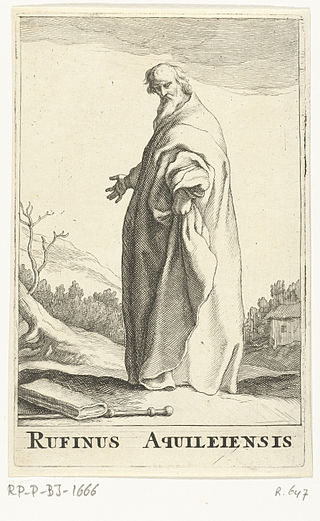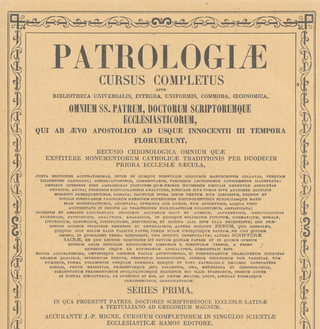Sources
- ↑ J. de Ghellinck, Le Mouvement Theologique du XIIe Siecle (1946), p. 34
 Herbermann, Charles, ed. (1913). "Haymo". Catholic Encyclopedia . New York: Robert Appleton Company.
Herbermann, Charles, ed. (1913). "Haymo". Catholic Encyclopedia . New York: Robert Appleton Company.
Haymo (or Haimo) (died 27 March 853) was a German Benedictine monk who served as bishop of Halberstadt, and was a noted author.
The exact date and place of Haymo's birth are unknown. He entered the Order of St. Benedict at Fulda as a youth, where the celebrated Rabanus Maurus was one of his fellow students. He went together with him to the Monastery of St. Martin at Tours to profit by the lessons of its great teacher, Alcuin.
After a brief sojourn at Tours, both friends came back to the Benedictine house at Fulda, and there they spent most of their life previous to their promotion to the episcopal dignity. Haymo became chancellor to the monastery, as is proved by his records of its transactions, which are still extant. It is probable that owing to his great learning he was also entrusted with the teaching of theology in the same monastery, but there is no positive proof of this.
He had been living for only a short while in the Benedictine monastery at Hersfeld, perhaps as its abbot, when in the last weeks of 840 he was nominated to the Bishopric of Halberstadt. Hearing of Haymo's promotion, Rabanus Maurus, his old friend, gave him at great length—in a work entitled "De Universo" and divided into 22 books—advice that would help him in the discharge of the episcopal office.
In compliance with Rabanus's suggestions, Haymo stood aloof from the Court of King Louis the German, did not entangle himself in the affairs of the State, preached often and lived solely for the welfare of his diocese. The only public assembly which he attended was the Council of Mainz, held in 847 for the maintenance of the ecclesiastical rights and immunities. Haymo died on 26 March 853.
There is no doubt that Haymo of Halberstadt was a prolific writer, although a number of works, particularly those of Haimo of Auxerre, have been wrongly ascribed to him. Most of his genuine works are commentaries on Holy Writ, the following of which have been printed: "In Psalmos explanatio"; "In Isaiam libri tres"; "In XII Prophetas"; "In Epistolas Pauli omnes" and "In Apocalypsim libri septem". As might be naturally expected from the exegetical methods of his day, Haymo is not an original commentator; he simply repeats or abridges the Scriptural explanations which he finds in patristic writings. As a pious monk, and a faithful observer of Rabanus's recommendations, he writes almost exclusively about the moral and mystical senses of the sacred text.
He is also the author of an Epitome of Eusebius's Ecclesiastical History , of a large number of sermons, and of a spiritual work, De amore coelestis patriae.
His works are contained in volumes cxvi-cxviii of Migne, Patrologia Latina .
Some homilies once attributed to Haymo of Halberstadt are now to be attributed to Haymo of Auxerre. [1]
Anselm of Laon, properly Ansel, was a French theologian and founder of a school of scholars who helped to pioneer biblical hermeneutics.

Rabanus Maurus Magnentius, also known as Hrabanus or Rhabanus, was a Frankish Benedictine monk, theologian, poet, encyclopedist and military writer who became archbishop of Mainz in East Francia. He was the author of the encyclopaedia De rerum naturis. He also wrote treatises on education and grammar and commentaries on the Bible. He was one of the most prominent teachers and writers of the Carolingian age, and was called "Praeceptor Germaniae", or "the teacher of Germany". In the most recent edition of the Roman Martyrology, his feast is given as 4 February and he is qualified as a Saint ('sanctus').

Tyrannius Rufinus, also called Rufinus of Aquileia, was a monk, philosopher, historian, and theologian who worked to translate Greek patristic material, especially the work of Origen, into Latin.

Walafrid, alternatively spelt Walahfrid, nicknamed Strabo, was an Alemannic Benedictine monk and theological writer who lived on Reichenau Island in southern Germany.

The Patrologia Latina is an enormous collection of the writings of the Church Fathers and other ecclesiastical writers published by Jacques-Paul Migne between 1841 and 1855, with indices published between 1862 and 1865. It is also known as the Latin series as it formed one half of Migne's Patrologiae Cursus Completus, the other part being the Patrologia Graeca of patristic and medieval Greek works with their medieval Latin translations.
Odo of Tournai, also known as Odoardus or Odo of Orléans (1060–1113), was a Benedictine monk, scholar and bishop of Cambrai.

Adso of Montier-en-Der was abbot of the Benedictine monastery of Montier-en-Der in France, and died on a pilgrimage to Jerusalem. Biographical information on Adso comes mainly from one single source and has come under question, but the traditional biography depicts him as an abbot who enacted important monastic reform, as a scholar, and as a writer of five hagiographies. His best-known work was a biography of Antichrist, titled "De ortu et tempore Antichristi", which combined exegetical and Sibylline lore. This letter became one of the best-known medieval descriptions of Antichrist, copied many times and of great influence on all later apocalyptic tradition, in part because, rather than as an exegesis of apocalyptic texts, he chose to describe Antichrist in the style of a hagiography.
Herigerus was a Benedictine monk, often known as Heriger of Lobbes for serving as abbot of the abbey of Lobbes between 990 and 1007. Remembered for his writings as theologian and historian, Herigerus was a teacher to numerous scholars. His biography describes him as "skilled in the art of music", though no music theory treatise survives and neither do the two antiphons and one hymn attributed to him.
Rodulfus, was an 11th-century Benedictine chronicler.
Haimo, also spelled Hamo, Heimo, Hamon, Haim, Haym, Heym, Aymo, Aimo, etc., is a masculine given name of Germanic origin. The Old French forms are Haimon, Aymon, Aimon, Aymes. It is a hypocoristic form of various Germanic names beginning with the radical haim-, meaning "home".
A homiliarium or homiliary is a collection of homilies, or familiar explanations of the Gospels.
Dungal of Bobbio was an Irish monk, teacher, astronomer, and poet. He was to live at Saint-Denis, Pavia, and Bobbio.
Candidus (Bruun) of Fulda was a Benedictine scholar of the ninth-century Carolingian Renaissance, a student of Einhard, and author of the vita of his abbot at Fulda, Eigil.
Rudolf of Fulda was a Benedictine monk during the Carolingian period in the 9th century. Rudolf was active at Fulda Abbey in the present-day German state of Hesse. He was one of the most distinguished scholars of his time. Many of his works have been lost. However, his Annals of Fulda and Life of St. Leoba survive.
Candidus was the name given to the Anglo-Saxon Wizo or Witto by Alcuin, whose scholar he was and with whom he went in 782 to Gaul. He is author of several philosophical texts wrongly attributed by earlier scholars to the benedictinian monk Brun Candidus of Fulda, the author of the vita of Abott Eigil of Fulda. But recent research into the manuscript tradition furnishing clear evidence attested the authorship of Candidus Wizo, the learned disciple of Alcuin. Based on his deep knowledge of the works of Saint Augustine of Hippo he tried to give proof of god's existence, to demonstrate that the incorporeal nature of god is conceivable only by means of the spiritual eye and excludes any possibility of viewing him by means of the corporeal eyes, and to elucidate the problem of the incarnation explaining its need by the weakness of the human cognition. At the palace school he was tutor to Gisla, the sister, and Rodtruda, the daughter of Charlemagne. When Alcuin went to Tours (796), Candidus was his successor as master of the palace school. Alcuin's esteem for Candidus is shown by his dedicating his commentary on Ecclesiastes to his friends Onias, Fredegisus, and Candidus.
Haimo of Auxerre was a member of the Benedictine Abbey of Saint-Germain d'Auxerre. Although he was the author of numerous Biblical commentaries and theological texts, little of his life is known today.

The Diocese of Fulda is a Latin Church diocese of th Catholic Church in the north of the German state of Hessen. It is a suffragan diocese of the Archdiocese of Paderborn. The bishop's seat is in Fulda Cathedral.
Smaragdus of Saint-Mihiel< OSB was a Benedictine monk of Saint-Mihiel Abbey near Verdun. He was a significant writer of homilies and commentaries.

The Abbey of Fulda, from 1221 the Princely Abbey of Fulda and from 1752 the Prince-Bishopric of Fulda, was a Benedictine abbey and ecclesiastical principality centered on Fulda, in the present-day German state of Hesse.

Berengaudus (840–892) was a Benedictine monk, supposed author of Expositio super septem visiones libri Apocalypsis, a Latin commentary on the Book of Revelation. He has traditionally been assumed to be a monk of Ferrières Abbey, at the time of Lupus Servatus. The attribution has been questioned, but the Expositio was later much circulated in manuscript. It was printed in Patrologia Latina vol. XVII under Ambrose, following an attribution by Cuthbert Tunstall.